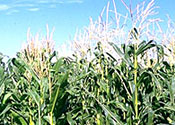Gene flow—also called migration—is any movement of genes from one population to another. Gene flow includes lots of different kinds of events, such as pollen being blown to a new destination or people moving to new cities or countries. If genes are carried to a population where those genes previously did not exist, gene flow can be a very important source of genetic variation. In the graphic below, the gene for brown coloration moves from one population to another.
The amount of gene flow that goes on between populations varies a lot depending on the type of organism.
As you would expect, populations of relatively sedentary organisms are more isolated from one another than populations of very mobile organisms.
Lower rate of gene flow:
Corn, which is wind-pollinated, may be unlikely to fertilize individuals more than 50 feet away.1
| ||
Higher rate of gene flow:
However, other organisms are able to distribute their genes much further. For example, fruit flies released in Death Valley were recaptured almost 15 kilometers away from the site of release.2
|
Gene flow has several important effects on evolution:
- Within a population:
It can introduce or reintroduce genes to a population, increasing the genetic variation of that population.
- Across populations:
By moving genes around, it can make distant populations genetically similar to one another, hence reducing the chance of speciation. The less gene flow between two populations, the more likely that two populations will evolve into two species.
No comments:
Post a Comment
Note: Only a member of this blog may post a comment.